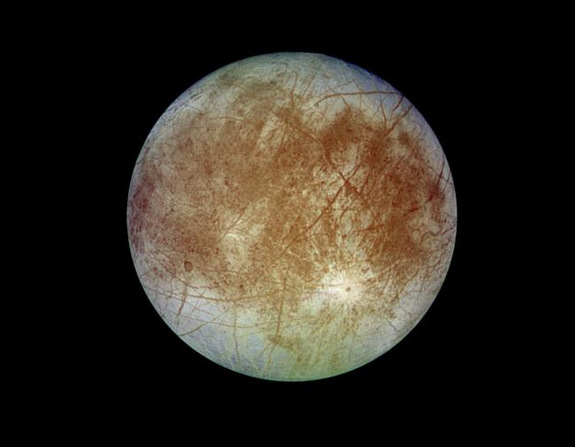February 12, 2015 – Or maybe he wouldn’t. In his novel, 2010: Space Odyssey Two, Clarke’s voyagers set out to find out what happened to a Jupiter mission a decade earlier. When they arrived in the vicinity of the Jovian planet they were mysteriously contacted by one of the astronauts of that mission, David Bowman, who warned them that something wonderful was going to happen and that they should get away from the planet asap. They did and from a distance watched as Jupiter was transformed into a second star within the Solar System with its light providing the energy to transform the frozen moon Europa into an ocean planet. Those bound for Earth received a message “All these worlds are yours except Europa. Attempt no landing there.”
And now NASA in its 2016 budget is proposing to mount an expedition to Europa, Jupiter’s sixth moon, one of the three believed to harbor water beneath their icy crusts. The other two, Ganymede and Callisto, don’t peak the same level of interest. That begs the question, “Why?” Why did Clarke pick Europa as this transformative “new Earth” in his novel?
Europa, seen below, is unique among the icy moons of the gas giant planets in our Solar System. Its surface is covered with strange markings and discolourations. It is the smoothest moon in the Solar System, displaying few craters on its surface. Instead of mountains and crater rings we see seams and cracks and a crust partially stained henna. The atmosphere, although tenuous, is largely composed of oxygen.
The gravitational pull of Jupiter exerts considerable tidal forces on the moon. It is believed that this is causing the visible plate tectonic activity recently reported. And it is also believed that these forces have heated the ice under the crust creating an ocean of water equivalent in volume to all found here on Earth. NASA has seen plumes of water escaping as icy geysers from Europa’s surface cracks. And recently NASA detected phyllosilicates on the surface, a clay-like mineral that on Earth is found in conjunction with organic matter. In other words, Europa may contain life.
Life on Europa was the idea behind the novel Clarke wrote back in 1982. He wasn’t around to witness the most recent discoveries that suggest his view was prescient. He had watched the NASA Grand Tour of the Solar System’s giant planets arrive at Jupiter in 1979 and wrote “2010: Space Odyssey Two” three years later. And he was convinced that if we did reach Europa and drill down through the ice we would discover an ecology unique to the Moon including creatures bigger than anything living in the geological record here on Earth.
So what is NASA contemplating? Called the “Europa Clipper,” the spacecraft would orbit Jupiter but like Cassini orbiting Saturn while studying Titan, would perform 45 flybys of the moon, some as close as 25 kilometers (16 miles) above its surface. On board would be ground-penetrating radar, an infrared spectrometer, magnetometers, and high-resolution imagers. It may even deploy cube micro-satellites which will be dropped into orbit around the moon. The science package would tell us the thickness of the surface crust, its composition, the temperature on its surface, and what lies beneath. The mission currently may use NASA’s Space Launch System (SLS), still in development, to shorten the voyage from Earth to Jupiter to under three years.
NASA isn’t alone in wanting to go to Europa. The European Space Agency (ESA) is also interested. They call their mission, JUICE, which stands for the Jupiter Icy Moons Explorer and plan to launch in 2022. Using Venus and Earth’s gravity to boost the spacecraft’s speed, it will take eight years to get to Jupiter, sometime in 2030. On board JUICE will be an instrumentation package similar to that contemplated for the Europa Clipper mission. But JUICE is not designed just to study Europa. Its mission includes a detailed study of Jupiter itself as well as Europa’s two sister ice moons, Callisto and Ganymede. In fact the mission’s final destination will be to go into orbit around Ganymede.
How interesting that both NASA and ESA have no plans to land on Europa. Are they heeding the words, “Attempt no landing there?”








